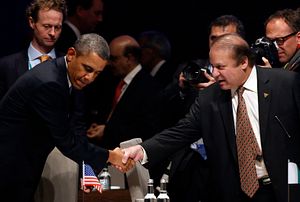A cartoon in Pakistan’s The Express Tribune perhaps best captured the country’s reaction to U.S. President Barack Obama’s January visit – his second – to India. It showed Obama and his Indian counterpart Narendra Modi meeting amicably in a tent while Pakistan is outside looking in. Understandably, many Pakistani officials are both jealous and upset over the recent bonhomie between Obama and Modi; the Pakistani foreign office said as much.
Obama’s concerted efforts to court India as part of Washington’s own shifting foreign policy objectives, coupled with the end of its military operations in Afghanistan, has tremendous implications for the security and economy of South Asia and beyond – for the better or not, remains to be seen.
Separation
Pakistan’s singular foreign policy objective is parity with India. But with neither the size nor the capital, Pakistan has recognized that it needs American assistance. Therefore, for much of its history, Pakistan has relied on American military and economic aid to maintain a bloated military disproportionate to its size. That same military has maintained a grip on Pakistani politics, either directly under a dictatorship or indirectly through rigging elections, coercing governments, and intimidation.
For the most part, the United States hasn’t especially minded. Even as late as 2008, former dictator Pervez Musharraf was a willing ally in America’s so-called War on Terror, and received billions of dollars in aid for his efforts. As the U.S. experimented with state building in Afghanistan, it required Pakistan’s help, given the influence Pakistan had with Afghan militias and warlords. But Pakistan had other ideas, and played what critics call a “double game.” It only fought militants that it thought posed a direct threat to the Pakistani state, and continued to fund, train and support militant groups that the Pakistani state thought would give it influence outside its border: Lashkar-e-Taiba (LeT) and Jaish-e-Muhammad in Indian-held Kashmir, and the Afghan Taliban and the Haqqani Network in Afghanistan.
The latter groups unremittingly thwarted American and Afghan efforts at stability, and derailed Pakistani-American relations in the process. Pakistan’s “Good Taliban Bad Taliban” policy, as it was called, coupled with continuing tensions between Pakistan’s civilian and military rulers brought Pakistani-American relations to a particularly low ebb during the last Pakistani civilian government’s tenure from 2008-2013.
The 2009 Kerry-Lugar Bill, officially known as the Enhanced Partnership With Pakistan Act, authorized $1.5 billion in aid for five years, but was met with derision and anger from the Pakistani military because the aid was contingent on strengthening civilian institutions. The Pakistani military conducted a smear campaign in the local media and organized anti-American protests to air their disapproval.
Meanwhile, the United States escalated its drone program.

































